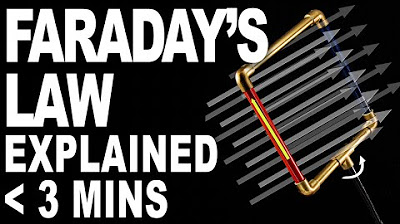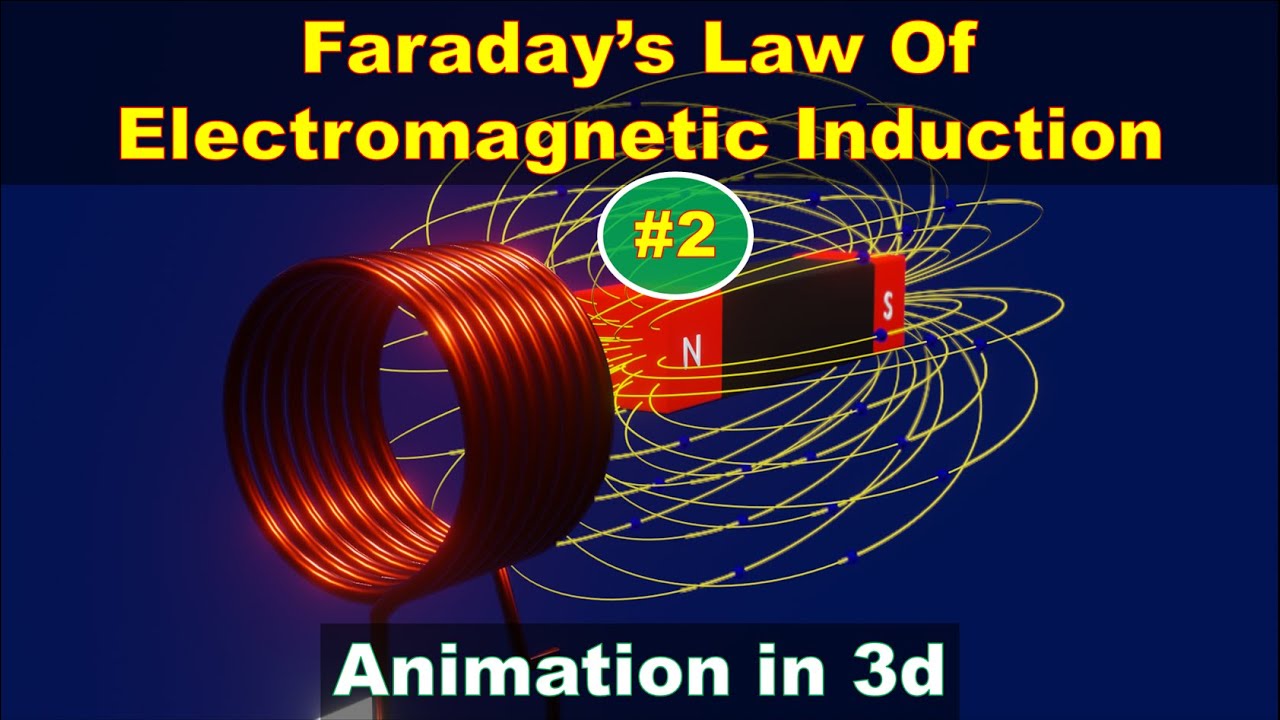Lenz's Law, Right Hand Rule, Induced Current, Electromagnetic Induction - Physics
TLDRThis video script delves into Lenz's Law, illustrating how it determines the direction of current in a coil when an induced electromotive force (emf) is present. The law states that an induced emf generates a current whose magnetic field opposes the change in magnetic flux that created it. The script uses examples to demonstrate how the induced current flows in a direction that either opposes or supports changes in magnetic flux, aiming to maintain equilibrium. The right-hand rule is applied to determine the direction of the induced current in various scenarios, highlighting the principle of the system's resistance to changes in flux.
Takeaways
- 🧲 Lenz's Law is a principle used to determine the direction of the current in a coil when an induced electromotive force (emf) is present.
- 🌀 An induced emf arises to oppose the change in magnetic flux that created it, according to Lenz's Law.
- 📈 The induced emf is proportional to the rate of change of magnetic flux; a faster change results in a greater induced emf.
- ➡️ If the change in magnetic flux is positive, the induced emf will be negative, indicating an opposition to the change.
- 🔄 The induced current creates a magnetic field that opposes the change in the original magnetic field.
- 👉 The direction of the induced current can be determined using the right-hand rule, which relates the direction of the current to the direction of the magnetic field it produces.
- 🔄 The system tries to maintain equilibrium; if the magnetic flux is increased, the induced current will flow to decrease it, and vice versa.
- 📉 When the magnetic flux decreases, the induced current will flow in a direction that increases the flux, supporting the original magnetic field.
- 🔧 The right-hand rule is a tool for visualizing the relationship between current and magnetic field direction in a wire.
- 🔄 The direction of the induced current in a coil can be used to either oppose or support changes in magnetic flux, depending on the situation.
- 🔗 Understanding Lenz's Law is crucial for predicting how changes in magnetic flux will affect the direction of induced currents in electrical circuits.
Q & A
What is Lenz's Law?
-Lenz's Law states that an induced electromotive force (emf) will always give rise to a current whose magnetic field opposes the original change in magnetic flux that created it.
How does the direction of induced current relate to the change in magnetic flux?
-The direction of the induced current is such that the magnetic field created by this current opposes the change in magnetic flux. If the magnetic flux is increasing, the induced current's magnetic field will oppose this increase; if the flux is decreasing, the induced current's magnetic field will try to support the flux.
What happens when a coil is exposed to an increasing magnetic field?
-When a coil is exposed to an increasing magnetic field, the magnetic flux through the coil increases. According to Lenz's Law, the induced emf will generate a current that creates a magnetic field opposing the increase in flux.
How does the induced emf relate to the rate of change of magnetic flux?
-The induced emf is proportional to the rate of change of the magnetic flux. The faster the change in flux, the greater the induced emf.
What does the negative sign in Faraday's Law of Induction signify?
-The negative sign in Faraday's Law of Induction indicates that the induced emf and the change in magnetic flux have opposite signs. This means the induced emf will always act to oppose the change in flux.
How can the right-hand rule be used to determine the direction of the induced current?
-Using the right-hand rule, if you wrap your right hand around a conductor with your thumb pointing in the direction of the current, your fingers will curl in the direction of the magnetic field generated by that current. This helps determine the direction of the induced current based on the desired magnetic field direction.
What happens to the magnetic field inside a coil when it is exposed to an external magnetic field?
-The magnetic field inside the coil will oppose the external magnetic field if the flux is increasing, creating an induced magnetic field in the opposite direction to reduce the increase in flux.
How does the system respond when the magnetic flux through a coil decreases?
-When the magnetic flux through a coil decreases, the system will generate an induced current to create a magnetic field that supports and increases the flux, attempting to bring the system back to equilibrium.
How does Lenz's Law help in maintaining a state of equilibrium?
-Lenz's Law helps maintain a state of equilibrium by generating an induced current that opposes changes in magnetic flux. This opposition works to counteract increases or decreases in flux, keeping the system balanced.
What is the direction of the induced current in a coil if the magnetic flux through it is increasing?
-If the magnetic flux through a coil is increasing, the induced current will flow in a direction that creates a magnetic field opposing the increase in flux. This is determined using Lenz's Law and the right-hand rule.
Outlines
🔋 Understanding Lenz's Law and Induced EMF
This paragraph introduces Lenz's Law, which describes how an induced electromotive force (EMF) generates a current in a coil to oppose changes in magnetic flux. The example given involves moving a coil into a constant magnetic field, causing an increase in magnetic flux and an induced EMF that opposes this change. The negative sign in the induced EMF formula signifies the opposition to the original flux change. The right-hand rule is used to determine the direction of the induced current, which creates a magnetic field opposing the external one, aiming to maintain equilibrium.
🌀 Flux Changes and Lenz's Law Application
The second paragraph explores how Lenz's Law applies when there's a decrease in magnetic flux through a coil. It uses the example of moving a coil away from a constant magnetic field, resulting in decreasing flux. The system, according to Lenz's Law, tries to increase the flux to restore equilibrium, inducing a current that supports the external magnetic field. The right-hand rule is again applied to determine the direction of the induced current, which flows in a way that the magnetic field generated by it is in the same direction as the decreasing external field.
🔄 Determining Induced Current Direction with Lenz's Law
The final paragraph summarizes the process of using Lenz's Law to determine the direction of the induced current in a coil. It emphasizes the system's attempt to maintain equilibrium by generating an induced current that opposes an increase or supports a decrease in magnetic flux. The right-hand rule is used to ascertain the direction of the current in various scenarios, including a coil above a straight wire with decreasing current. The paragraph concludes by reiterating the fundamental concept of Lenz's Law as the system's effort to maintain equilibrium in the presence of changing magnetic flux.
Mindmap
Keywords
💡Lenz's Law
💡Induced EMF
💡Magnetic Flux
💡Right-Hand Rule
💡Magnetic Field
💡Equilibrium
💡Coil
💡Direction of Current
💡Oppose
💡Support
💡Counterclockwise
Highlights
Lenz's Law is discussed to determine the direction of current in a coil with induced EMF.
Induced EMF arises to oppose the change in magnetic flux that created it.
The negative sign in induced EMF equations indicates opposition to the original flux change.
An example demonstrates how moving a coil into a magnetic field increases flux and induces EMF.
The Right-Hand Rule is used to determine the direction of the induced magnetic field and current.
Clockwise current flow is explained using the Right-Hand Rule for a specific wire segment.
The system's attempt to maintain equilibrium is highlighted when flux changes.
An example of decreasing flux and the system's response to increase it is provided.
The direction of the induced magnetic field is the same when supporting a decrease in flux.
A second example with a long wire and a circular coil illustrates Lenz's Law in action.
The direction of induced current in a coil above a wire with decreasing current is determined.
The importance of determining the induced magnetic field's direction for current direction is emphasized.
The counterclockwise direction of induced current is explained in a specific scenario.
Lenz's Law is summarized as the system's effort to maintain equilibrium in magnetic flux.
The process of using Lenz's Law to find the induced current direction is outlined.
The video concludes with a reiteration of the basic concept behind Lenz's Law.
Transcripts
Browse More Related Video

Magnetic (AP Physics SuperCram Review)

Faraday's & Lenz's Law of Electromagnetic Induction, Induced EMF, Magnetic Flux, Transformers

Faradays Law in 3 minutes

Induction - An Introduction: Crash Course Physics #34

Faraday's Law of Electromagnetic Induction, Magnetic Flux & Induced EMF - Physics & Electromagnetism

michael faraday | law of electromagnetic induction | faraday's law of induction
5.0 / 5 (0 votes)
Thanks for rating: